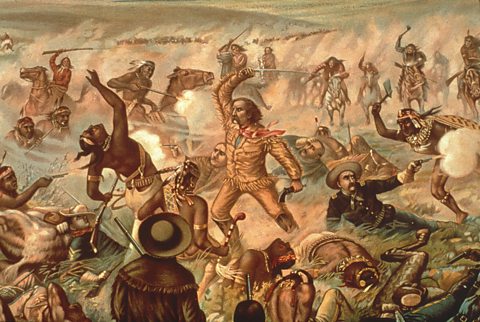Battle of Little Bighorn
Background
- Chiefs Crazy Horse and Sitting Bull refused to accept the peace of 1868
- Gold was discovered in the Black Hills in 1874
- The Sioux refused to sell their land in the Black Hills
- The government ordered the Sioux onto small reservations. When the Sioux refused, they were declared
hostile
1876 campaign, battle preparation
- General Philip Sheridan was sent to defeat the Sioux
- In June 1876 US armies, led by the generals Alfred Terry and John Gibbon, met at the Yellowstone river
- Gibbon was set to march up the Little Bighorn River, and Lt Colonel George Custer was ordered to march round the Wolf Mountains, as part of a two-pronged attack on the Sioux camp
To the Little Bighorn
- The Sioux had been joined by the Cheyenne and Arapaho, making an army of more than 3,000 warriors, armed with Winchester repeating rifles
- Custer marched his men through (not round) the Wolf Mountains, to arrive at the Sioux camp first
- Custer divided his 600 men into three groups
Custer's last stand
- Custer sent Captain Frederick Benteen scouting, and sent Major Marcus Reno to attack the Sioux village from the south
- Custer headed north of the village with 215 men
- The Sioux cut off both Reno and Custer. Benteen rescued Reno, but Custer and all of his troops lost their lives
- The Sioux withdrew when Terry and Gibbon arrived

'Custer's Last Fight'. Painting by Cassilly Adams, 1895.